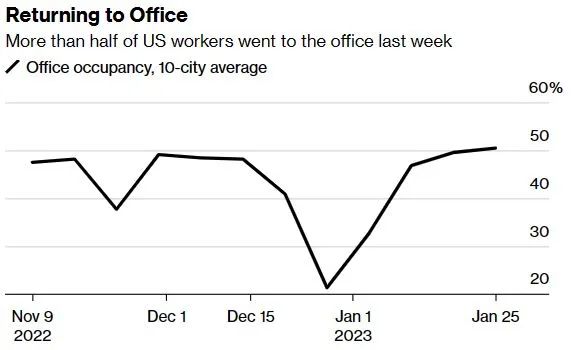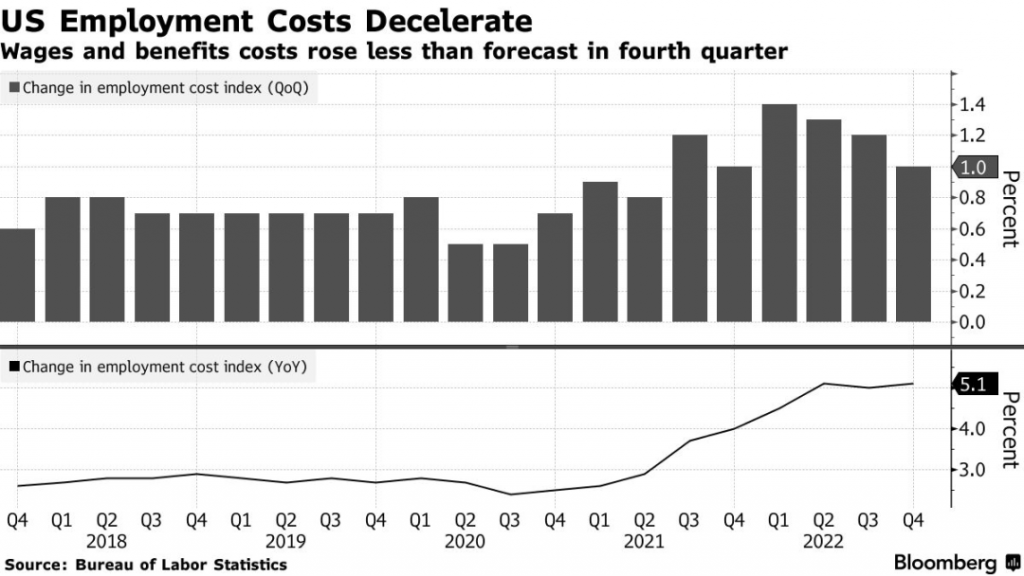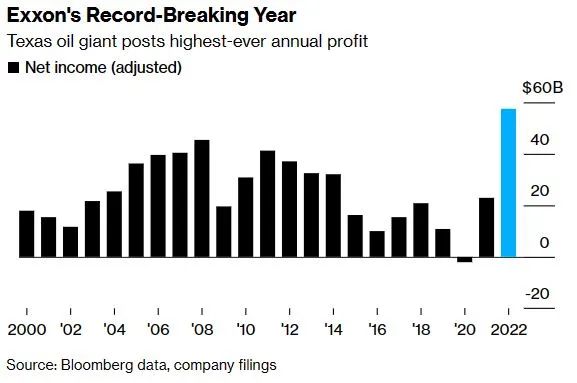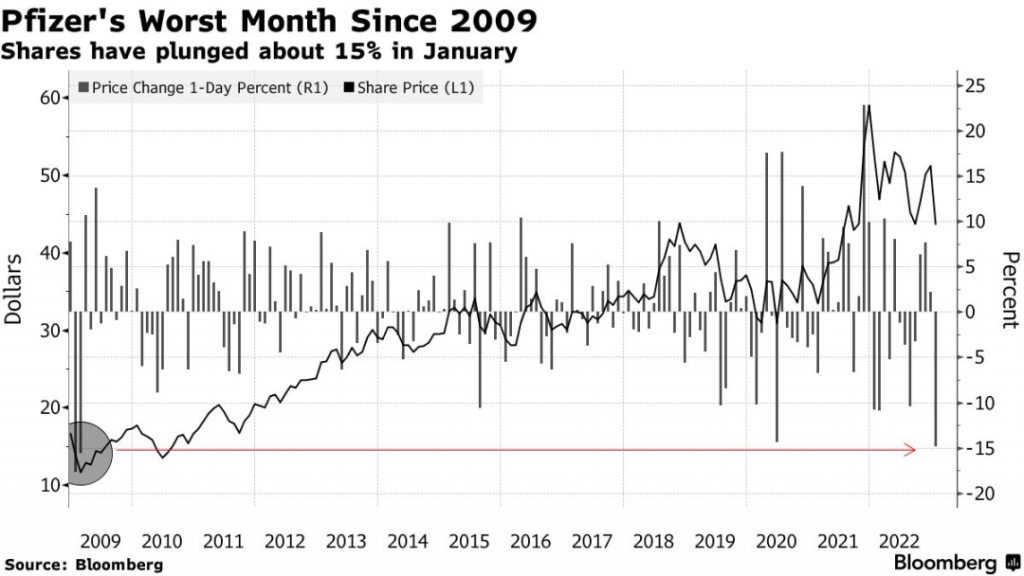—— Alibaba Plunges 9%, Rally Falters; U.S. Office Use Tops 50%; Labor Cost Inflation Slows; Exxon Profits Surge, Disappoints Shareholders; Case-Shiller Index Falls Five Months Straight; Pfizer Loses $43B in Value; 600,000 Move Out of NY and California
1. Alibaba Plunges 9%, Rally Falters
This week, Alibaba Group’s share price plunged 9.1%, wiping out $28 billion in market value and trimming its monthly gain to 25%.
Investors are beginning to question whether Alibaba’s stock has overly priced in its actual recovery potential. They are also awaiting further macroeconomic data. Banny Lam, head of research at Ceb International Inv, said investors need more corporate guidance on earnings, and short-term volatility may remain high.
In January, most Hang Seng Index components rallied on China’s economic reopening. But since October, Alibaba’s share price has already jumped 75%. Tencent and NetEase have also shown signs of being overbought.
Meanwhile, Alibaba’s put-to-call ratio rose this month, suggesting that investors are becoming increasingly cautious.
This week, Alibaba’s shares fell 9% in total, as many investors opted to take short-term profits.

______
2. U.S. Office Use Tops 50%
According to data from security firm Kastle Systems, during the week ending January 25, office occupancy in America’s top 10 cities rose 0.9% to 50.4%. This means more than half of U.S. workers returned to the office last week.
Kastle collects office occupancy data based on building access card swipes.
All cities tracked—including Chicago, San Francisco, and Austin—saw occupancy rates exceed 40% for the first time since the pandemic.
New York and San Francisco posted occupancy rates of 47.5% and 45.9%, respectively. Austin led with 68%, while San Jose—part of Silicon Valley—was lowest at 41%.
U.S. office buildings have temporarily surpassed 50% occupancy for the first time.

______
3. Labor Cost Inflation Slows
According to data released today by the U.S. Labor Department, the Employment Cost Index rose just 1% in Q4, coming in below expectations—another sign that inflation may be easing.
Over the past six quarters, labor costs had risen more than 1% quarter-over-quarter, the longest streak since 1996. Labor costs rose 5.1% year-over-year. However, excluding performance-linked pay, labor costs have decreased.
Despite signs of slowing wage inflation, the Fed remains unconvinced that price inflation is under control. Fed Chair Jerome Powell is expected to maintain a hawkish tone this week and delay any rate cuts. His key concern is the cost of services excluding energy and housing.
Wage and bonus inflation was milder than expected, giving the Fed more room to maneuver.

______
4. Exxon Profits Surge, Shareholders Disappointed
Exxon Mobil announced today that its 2022 net profit jumped 157% year-over-year to $59 billion, smashing the previous record of $45.2 billion set in 2008.
However, the company did not announce any increase in share buybacks. As a result, Exxon’s shares fell 2.6% today.
Last week, rival Chevron missed earnings expectations but still announced a $75 billion share buyback plan.
After a cash-rich 2022, the world’s five largest oil firms face investor demands for higher dividends and buybacks. At the same time, governments are pressuring them to pay windfall taxes.
Exxon previously raised its buyback target multiple times and plans to repurchase up to $50 billion by 2024. CFO Kathy Mikells told analysts the company is taking a “balanced” approach—reducing debt while investing in new projects.
Despite record profits, Exxon seems unwilling to increase shareholder returns.

______
5. Case-Shiller Index Falls Five Months Straight
In November 2022, the S&P CoreLogic Case-Shiller Home Price Index fell 0.3% month-over-month, down 2.5% from its June peak.
Rising mortgage rates cooled the housing market quickly, with existing home sales plunging at the sharpest pace in over a decade.
In high-cost cities like San Francisco, home prices fell 1.6% year-over-year—the largest drop in more than ten years.
Craig Lazzara, managing director at S&P Dow Jones Indices, said that mortgage rates and affordability remain the biggest headwinds. A recession would further hurt buyers, so home prices still have room to decline.
Although home prices edged down, they remain 7.7% higher than a year ago. However, at the start of 2023, buyers seem to have more leverage, and market conditions are tilting in their favor.
In 2023, buyers have more negotiating power, but prices and rates remain unfriendly.

______
6. Pfizer Loses $43B in Value in January
In January, pharmaceutical giant Pfizer’s stock dropped 15%, wiping out $43 billion in market value—the company’s worst month since 2009.
During the pandemic, Pfizer’s COVID vaccines and drugs generated billions in revenue, sending its stock soaring. But in its latest earnings report, Pfizer said demand for these products is likely to decline, and annual revenue may miss expectations.
Barclays analyst Carter Gould said the market had already priced in weaker COVID revenues, as the worst of the pandemic has passed. Pfizer shares performed poorly this month and are unlikely to rebound sharply in the near term.
Pfizer’s stock peaked in 2021, but declining COVID-related revenue has now driven it sharply lower.

______
7. 600,000 Move Out of NY and California
According to a new report by the National Association of Realtors (NAR), in 2022, many Americans relocated to states with lower taxes and better weather—particularly Florida and Texas. California, New York, and Illinois lost the most residents.
In recent years, remote work has allowed Americans to move to lower-tax states, especially in the Sunbelt.
As offices reopened, many who had left big cities were called back. But rising rents and living costs caused many to reject the return.
NAR economist Nadia Evangelou said 2022 saw record-low housing affordability, which was a key reason people left cities like New York.
Florida welcomed 319,000 new residents in 2022, up 1.9% year-over-year. In contrast, California lost 343,000 people, and nearly 300,000 left New York.
The pandemic, remote work, and inflation have accelerated population outflows from states like California and New York.

______
This content is sourced from Financial Times, Bloomberg, and The Real Deal, among other financial news outlets.
